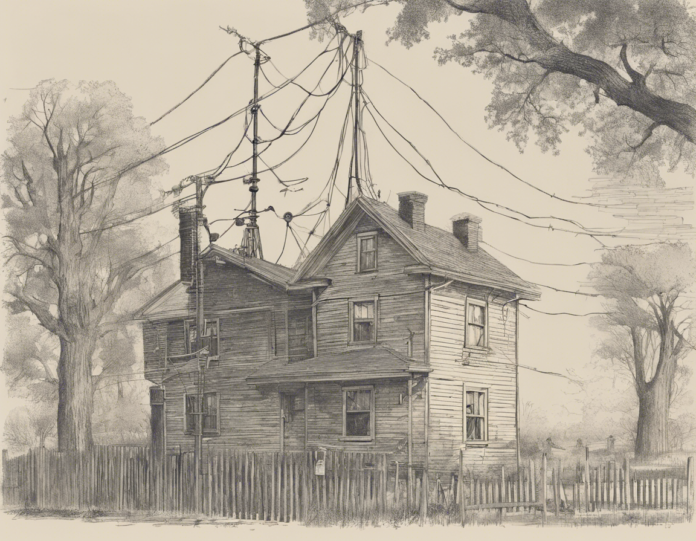In the modern digital age, antennas have become a familiar sight on rooftops across the world. These structures are essential components for receiving broadcast signals for television, radio, mobile phone services, and even internet connectivity. Whether you live in a bustling city or a remote countryside, the sight of an antenna perched atop a building is a common occurrence.
Understanding Antennas
Antennas are devices designed to transmit or receive electromagnetic waves. They can come in various shapes and sizes, depending on their intended use and the frequencies of signals they are meant to handle. The most common types of antennas include:
-
Dipole Antennas: This simple antenna consists of two conductors that are balanced and fed with a balanced transmission line. Dipole antennas are widely used for radio and television transmissions.
-
Yagi-Uda Antennas: Also known as beam antennas, these directional antennas are often used for communication purposes, such as ham radio operations and TV reception.
-
Parabolic Antennas: Shaped like a dish, these antennas are highly directional and are commonly used for satellite communication and radar systems.
-
Omni-Directional Antennas: These antennas radiate and receive signals in all directions, making them ideal for applications where signals come from various directions, such as mobile phone antennas.
Why Antennas Are Placed on Rooftops
Rooftops are ideal locations for installing antennas due to several reasons:
-
Line of Sight: Placing antennas at a higher elevation provides a clear line of sight to transmit and receive signals without obstructions. This is crucial for minimizing interference and maximizing signal strength.
-
Coverage: Rooftop antennas can offer broader coverage, reaching a larger area with their signals compared to antennas installed at lower heights.
-
Interference Reduction: Elevated antennas can reduce interference from surrounding buildings, trees, and other obstacles that may obstruct communication signals.
-
Safety: Mounting antennas on rooftops keeps them out of reach of potential vandalism or tampering, ensuring their security and uninterrupted performance.
Installing Antennas on Rooftops
When installing antennas on rooftops, several factors need to be considered to ensure optimal performance:
-
Structural Integrity: Before installing an antenna, it is essential to assess the rooftop’s structural integrity to support the weight and wind load of the antenna system.
-
Grounding: Proper grounding of the antenna system is crucial to protect against lightning strikes and ensure electrical safety.
-
Clearance: Antennas should have sufficient clearance from power lines, nearby structures, and other antennas to prevent interference and compliance with safety regulations.
-
Orientation: The orientation and tilt of the antenna play a vital role in signal reception. Aligning the antenna correctly towards the signal source can significantly improve performance.
Benefits of Rooftop Antennas
Rooftop antennas offer numerous benefits, including:
-
Improved Signal Reception: By being placed at an elevated position, rooftop antennas can receive stronger and clearer signals, resulting in better audio and visual quality for television and radio broadcasts.
-
Reliability: Rooftop antennas are less susceptible to interference and signal disruptions compared to indoor antennas, providing a more reliable connection.
-
Versatility: Rooftop antennas can be used for various applications, including TV reception, radio broadcasting, cellular communication, and internet connectivity.
-
Cost-Effectiveness: While the initial investment in a rooftop antenna setup may be higher, the long-term cost savings from reliable signal reception and reduced subscription fees for cable or satellite services make it a cost-effective choice for many users.
Maintenance and Considerations
To ensure optimal performance and longevity of rooftop antennas, regular maintenance and considerations are essential:
-
Weatherproofing: Antennas and their mounting equipment should be weatherproofed to withstand exposure to harsh elements and prevent damage.
-
Periodic Inspection: Regular inspections of the antenna system for any signs of damage, rust, loose connections, or misalignment are necessary to address issues promptly.
-
Cleaning: Keeping the antenna and its components clean from dirt, dust, and debris helps maintain optimal signal reception and prevents corrosion.
-
Upgrades: As technology advances, upgrading the antenna system to support newer frequencies and technologies can enhance performance and compatibility with modern devices.
Frequently Asked Questions (FAQs)
- Do rooftop antennas work better than indoor antennas for TV reception?
-
Yes, rooftop antennas typically provide better signal reception for television broadcasts due to their elevated position and clear line of sight.
-
Can I install a rooftop antenna myself, or do I need professional help?
-
While it is possible to install a rooftop antenna yourself, it is recommended to seek professional assistance to ensure proper positioning, grounding, and compliance with regulations.
-
What should I do if my rooftop antenna is not picking up signals properly?
-
Check for any obstructions blocking the antenna’s line of sight, ensure proper alignment and orientation, and consider upgrading to a more powerful antenna if needed.
-
Are rooftop antennas susceptible to lightning strikes?
-
Rooftop antennas are at risk of lightning strikes, which is why proper grounding and surge protection measures should be implemented to safeguard the antenna system and the building.
-
Can I use a rooftop antenna for both TV and internet connectivity?
- Yes, rooftop antennas can be used for various purposes, including TV reception and internet connectivity, depending on the type and configuration of the antenna system.
In conclusion, rooftop antennas play a vital role in modern communication systems, providing reliable signal reception for television, radio, mobile services, and internet connectivity. By understanding the benefits, considerations, and maintenance practices associated with rooftop antennas, users can maximize their performance and enjoy clear and uninterrupted communication services.

